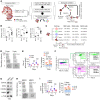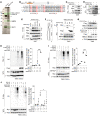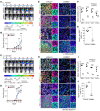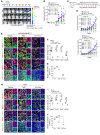Epigenetic modulator inhibition overcomes temozolomide chemoresistance and antagonizes tumor recurrence of glioblastoma
- PMID: 33016927
- PMCID: PMC7598052
- DOI: 10.1172/JCI127916
Epigenetic modulator inhibition overcomes temozolomide chemoresistance and antagonizes tumor recurrence of glioblastoma
Abstract
Glioblastoma multiforme (GBM) heterogeneity causes a greater number of deaths than any other brain tumor, despite the availability of alkylating chemotherapy. GBM stem-like cells (GSCs) contribute to GBM complexity and chemoresistance, but it remains challenging to identify and target GSCs or factors that control their activity. Here, we identified a specific GSC subset and show that activity of these cells is positively regulated by stabilization of methyl CpG binding domain 3 (MBD3) protein. MBD3 binds to CK1A and to BTRCP E3 ubiquitin ligase, triggering MBD3 degradation, suggesting that modulating this circuit could antagonize GBM recurrence. Accordingly, xenograft mice treated with the CK1A activator pyrvinium pamoate (Pyr-Pam) showed enhanced MBD3 degradation in cells expressing high levels of O6-methylguanine-DNA methyltransferase (MGMT) and in GSCs, overcoming temozolomide chemoresistance. Pyr-Pam blocked recruitment of MBD3 and the repressive nucleosome remodeling and deacetylase (NuRD) complex to neurogenesis-associated gene loci and increased acetyl-histone H3 activity and GSC differentiation. We conclude that CK1A/BTRCP/MBD3/NuRD signaling modulates GSC activation and malignancy, and that targeting this signaling could suppress GSC proliferation and GBM recurrence.
Keywords: Brain cancer; Drug therapy; Epigenetics; Oncology; Stem cells.
Conflict of interest statement
Figures











Similar articles
-
The histone demethylase KDM5A is a key factor for the resistance to temozolomide in glioblastoma.Cell Cycle. 2015;14(21):3418-29. doi: 10.1080/15384101.2015.1090063. Cell Cycle. 2015. PMID: 26566863 Free PMC article.
-
20(S)-ginsenoside-Rg3 reverses temozolomide resistance and restrains epithelial-mesenchymal transition progression in glioblastoma.Cancer Sci. 2019 Jan;110(1):389-400. doi: 10.1111/cas.13881. Epub 2018 Dec 14. Cancer Sci. 2019. PMID: 30431207 Free PMC article.
-
Mechanisms and Antitumor Activity of a Binary EGFR/DNA-Targeting Strategy Overcomes Resistance of Glioblastoma Stem Cells to Temozolomide.Clin Cancer Res. 2019 Dec 15;25(24):7594-7608. doi: 10.1158/1078-0432.CCR-19-0955. Epub 2019 Sep 20. Clin Cancer Res. 2019. PMID: 31540977
-
Regulation of expression of O6-methylguanine-DNA methyltransferase and the treatment of glioblastoma (Review).Int J Oncol. 2015 Aug;47(2):417-28. doi: 10.3892/ijo.2015.3026. Epub 2015 May 29. Int J Oncol. 2015. PMID: 26035292 Free PMC article. Review.
-
The Impact of Epigenetic Modifications on Adaptive Resistance Evolution in Glioblastoma.Int J Mol Sci. 2021 Aug 3;22(15):8324. doi: 10.3390/ijms22158324. Int J Mol Sci. 2021. PMID: 34361090 Free PMC article. Review.
Cited by
-
Inhibitory effects of temozolomide on glioma cells is sensitized by RSL3-induced ferroptosis but negatively correlated with expression of ferritin heavy chain 1 and ferritin light chain.Lab Invest. 2022 Jul;102(7):741-752. doi: 10.1038/s41374-022-00779-7. Epub 2022 Mar 28. Lab Invest. 2022. PMID: 35351965
-
Regulatory mechanisms of O6-methylguanine methyltransferase expression in glioma cells.Sci Prog. 2025 Apr-Jun;108(2):368504251345014. doi: 10.1177/00368504251345014. Epub 2025 Jun 16. Sci Prog. 2025. PMID: 40519114 Free PMC article. Review.
-
RBBP4-p300 axis modulates expression of genes essential for cell survival and is a potential target for therapy in glioblastoma.Neuro Oncol. 2022 Aug 1;24(8):1261-1272. doi: 10.1093/neuonc/noac051. Neuro Oncol. 2022. PMID: 35231103 Free PMC article.
-
Overcoming temozolomide resistance in glioma: recent advances and mechanistic insights.Acta Neuropathol Commun. 2025 Jun 5;13(1):126. doi: 10.1186/s40478-025-02046-4. Acta Neuropathol Commun. 2025. PMID: 40468460 Free PMC article. Review.
-
Epigenetics of Most Aggressive Solid Tumors: Pathways, Targets and Treatments.Cancers (Basel). 2021 Jun 27;13(13):3209. doi: 10.3390/cancers13133209. Cancers (Basel). 2021. PMID: 34198989 Free PMC article. Review.
References
Publication types
MeSH terms
Substances
Grants and funding
LinkOut - more resources
Full Text Sources
Medical
Research Materials
Miscellaneous

